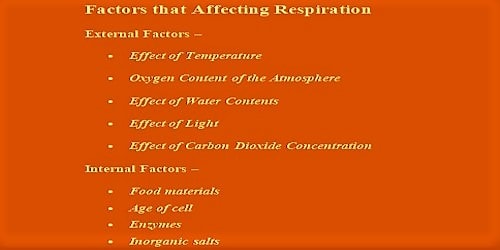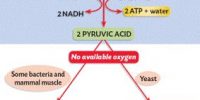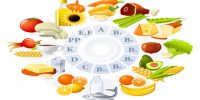The breakdown of food to discharge energy is called respiration. The key food used by cells for respiration is glucose. Respiration converts oxygen and the sugars generated during photosynthesis into carbon dioxide, water, and energy.
Affecting Factors of Respiration may either be external or internal:
External Factors:
- Effect of Temperature:
Like most substance reactions, the rate of respiration is deeply influenced by temperature. Below 20 C and above 45 C the rate of respiration reduces. The optimum temperature for respiration is 20 C – 45 C. It should be borne in mind that dissimilar plants or plant parts might confirm a substantial difference in regard to the optimum temperature for respiration. Plants in temperate climates have much lower respiration rates in winter than throughout warm summers.
- Oxygen Content of the Atmosphere:
The proportion of oxygen in the immediate atmosphere deeply influences the rate of respiration. If the amount of oxygen is reduced the rate of respiration will reduce. But the reduction of the oxygen content of the air, however, causes no momentous lowering in the respiratory rate until the proportion drops to about 10%. The rate of respiration for most plants peaks around the usual oxygen level in the atmosphere. At 5% oxygen exact retardation of respiration occurs.
- Effect of Water Contents:
Over a confident range, the water content of the plant tissue deeply influences its rate of respiration. Optimum supply of water maintains the rate of respiration normal. The rate of respiration reduces for a scarcity of water. With the increase in humidity substance, the rate of respiration is probably to go up with the consequence a rapid loss of feasibility will happen and at the similar time the temperature will also increase and the grain may be spoiled. The respiratory rate increases with the increase in water content of the respiring organism.
- Effect of Light:
Light has indirect effects on the rate of respiration. The stomata open in the light, so the rate of respiration comparatively high in the daytime. With the augment in light strength, the temperature of the adjoining atmosphere also increases thus affecting the rate of respiration. Light controls respiration by raising the temperature of an organism.
- Effect of Carbon Dioxide Concentration:
The rate of respiration is usually not affected by the increase of carbon dioxide concentration in the adjoining environment up to 19%, but as the absorption increases from 10% to 80%, a progressive decrease in respiration occurs. With the increase of Carbon dioxide (CO2) in the air, a rate of respiration decreases slightly. Increase in carbon dioxide absorption and deficiency of oxygen adversely affects the rate of aerobic respiration.
Internal Factors:
- Food materials: During respiration food materials break to release water and CO2. So the quality and quantity of food materials in the cell regulates the rate of respiration.
- Age of cell: Rate of respiration is maximum in young cells especially in meristematic cells (as there is much protoplasm).
- Enzymes: Different reactions of respiration need different kinds of enzymes. The process completely depends on their presence.
- Inorganic salts: Rate of respiration increases if there are more inorganic salts in the cell.












